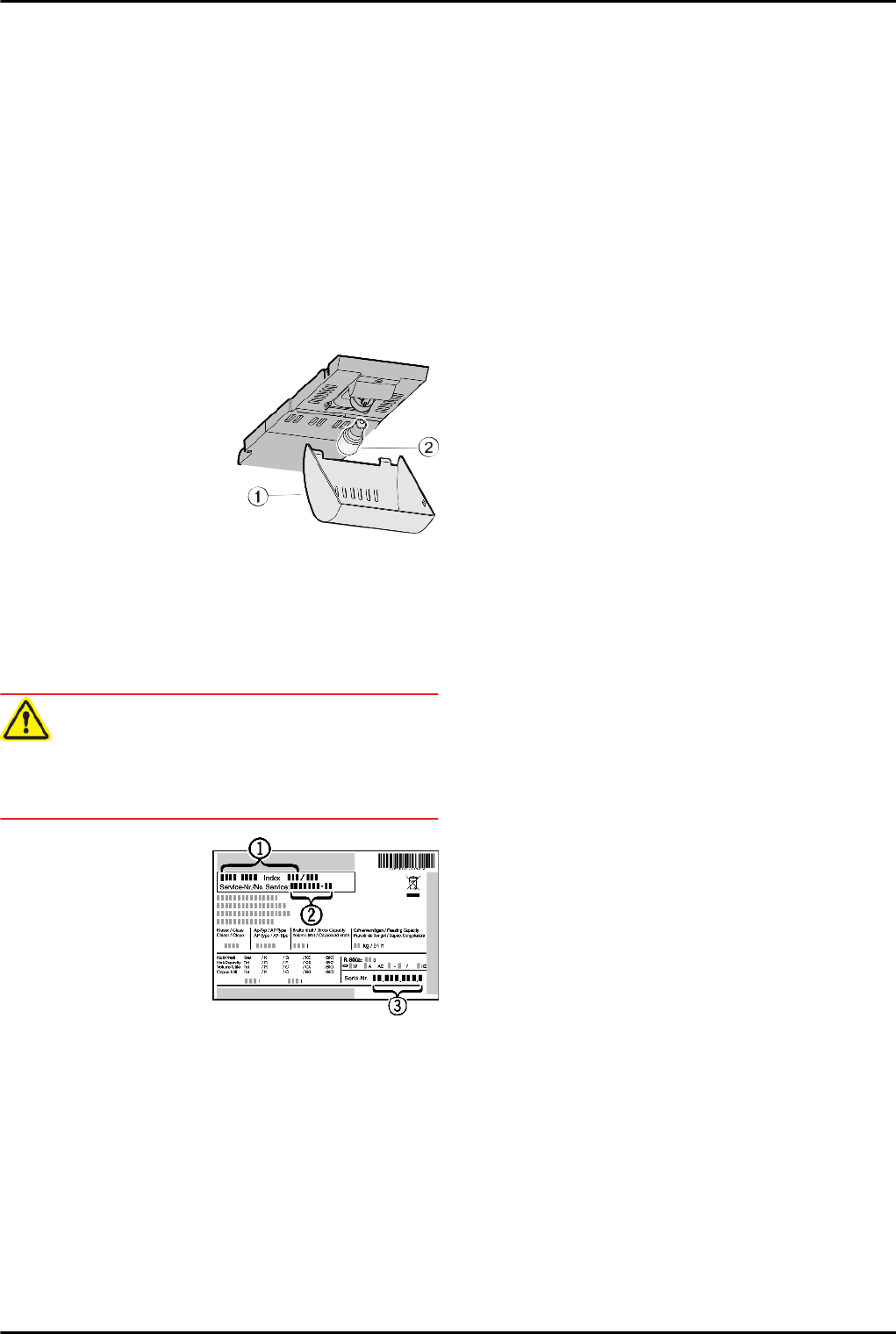
u
Remove the drawer.
u
Clean the ice cube tray with warm water. If necessary, use mild
washing-up liquid. Then rinse.
Switch the IceMaker on again.
u
Press the ON/OFF button until the LED shines, then slide in
the drawer.
w
The IceMaker starts producing ice cubes.
If washing-up liquid was used:
u
throw away the first three loads of ice cubes to get rid of any
remaining washing-up liquid.
6.4 Changing the interior light with bulb
Bulb data
max. 25 W
Fitting: E14
Type of current and voltage must conform with the details on
the type plate
u
Switch off the appliance.
u
Pull out the power plug or
switch off the fuse.
u
Take holder of the cover
Fig. 14 (1)
at the front and
unhook it at the back.
u
Change the bulb
Fig. 14 (2)
.
u
Put the cover
Fig. 14 (1)
back in place.
Fig. 14
6.5 Customer service
First check whether you can correct the fault yourself by refer-
ence to the list (see Malfunction). If this is not the case, please
contact the customer service whose address is given in the
enclosed customer service list.
WARNING
Risk of injury if repair work is not carried out professionally!
u
Have any repairs to and intervention in the appliance and
mains power cable, which are not expressly mentioned in the
(see Maintenance) carried out by the customer service only.
u
Read the appliance
designation
Fig. 15 (1)
, service
No.
Fig. 15 (2)
and
serial No.
Fig. 15 (3)
off
the type plate located
inside the appliance
on the left-hand side.
Fig. 15
u
Notify the customer service, specifying the fault, appliance
designation
Fig. 15 (1)
, service No.
Fig. 15 (2)
and serial No.
Fig. 15 (3)
.
w
This will help us to provide you with a faster and more accurate
service.
u
Keep the appliance closed until the customer service arrives.
w
The food will stay cool longer.
u
Pull out the mains plug (not by pulling the connecting cable)
or switch off the fuse.
7 Malfunction
Your appliance is designed and manufactured for a long life span
and reliable operation. If a malfunction nonetheless occurs
during operation, check whether it is due to a handling error. In
this case you will have to be charged for the costs incurred, even
during the warranty period. You may be able to rectify the
following faults yourself:
Appliance does not work.
→
The appliance is not switched on.
u
Switch on the appliance.
→
The power plug is not properly inserted in the wall socket.
u
Check power plug.
→
The fuse of the wall socket is not in order.
u
Check fuse.
The compressor runs for a long time.
→
The compressor switches to a low speed when little cold is
needed. Although the running time is increased as a result,
energy is saved.
u
This is normal in energy-saving models.
→
SuperFrost is activated.
u
The compressor runs for longer in order to rapidly cool the
food. This is normal.
Excessive noise.
→
Speed-controlled* compressors may produce varying
running noise due to different speed steps.
u
The sound is normal.
A bubbling and gurgling noise.
→
This noise comes from the refrigerant flowing in the refriger-
ation circuit.
u
The sound is normal.
A quiet clicking noise.
→
The noise is produced whenever the refrigeration unit (motor)
automatically switches on or off.
u
The sound is normal.
A hum. It is briefly a little louder when the refrigeration unit
(the motor) switches on.
→
The refrigeration increases automatically when the Super-
Frost, function is activated, fresh food has just been placed
in the appliance or the door has been left open for a while.
u
The sound is normal.
→
The ambient temperature is too high.
u
Solution: (see 1.2)
A low hum.
→
The sound is produced by air flow noise of the fan.
u
The sound is normal.
Vibratory noise.
→
The appliance is not standing firmly on the floor. As a result,
adjoining units or objects are set into vibration by the running
refrigeration unit.
u
Move the appliance away a little and align it using the adjust-
able feet.
u
Move bottles and containers apart.
Hum of the water tank pump.*
→
When water is pumped out of the water reservoir, a brief hum
of the pump can be heard.
u
The sound is normal.
The SuperFrost button flashes together with the tempera-
ture display.
→
There is a fault.
u
Contact the customer service. (see Maintenance).
The IceMaker cannot be switched on. *
→
The appliance and therefore the IceMaker are not connected.
u
Connect the appliance. (see Putting into operation).
The IceMaker does not make any ice cubes.*
→
The IceMaker is not switched on.
u
Switch on the IceMaker.
→
The drawer of the IceMaker is not properly closed.
u
Close the drawer properly.
→
The water tank is not correctly inserted.
Malfunction
12
















